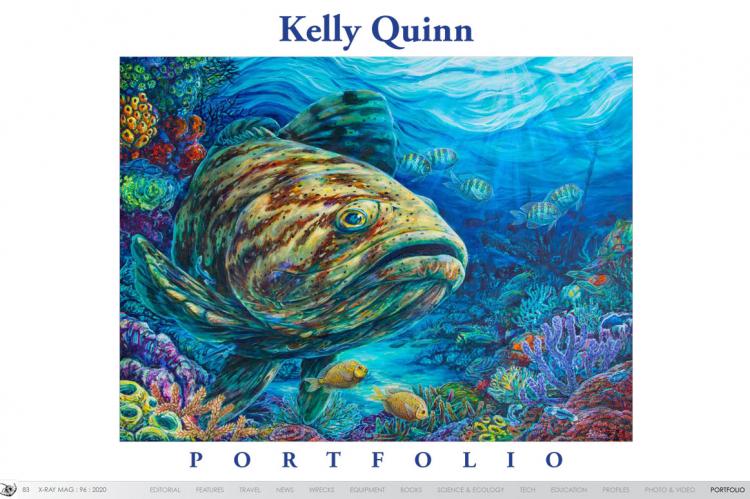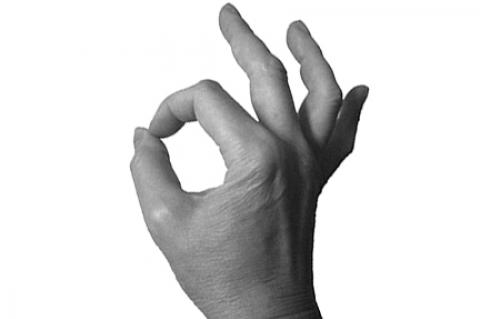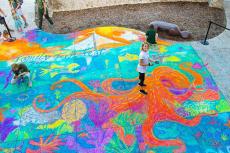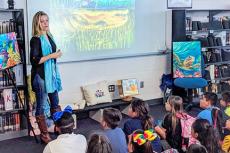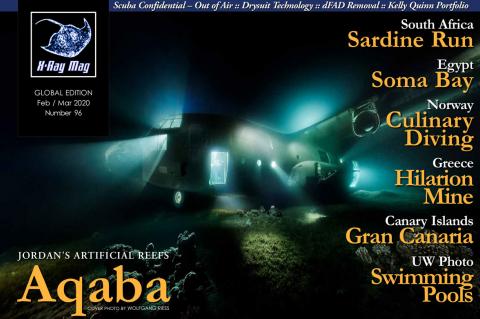Kelly Quinn Portfolio
American artist and educator Kelly Quinn creates vivid, dynamic paintings of marine life and reefs with brilliant color in detailed compositions. She is currently the artist-in-residence at The Florida Aquarium in Tampa, where she gives younger generations insights into the planet’s fragile marine ecosystems. X-Ray Mag interviewed the artist to find out more about her artwork and her mission to connect audiences to conservation through the power of art.
Tags & Taxonomy
"I believe the protection of our oceans and lands needs to be one of the most important topics on the minds of humanity from every walk of life. Without the ethical and logical protection of our planet’s resources and the very life that gives it vitality, we are slowly destroying everything we have worked to achieve."
— Kelly Quinn
X-RAY MAG: Tell us about yourself, your background and how you became an artist.
KQ: I grew up in central Florida, and my curiosity was molded by the wild land that surrounded me. From mystical cypress wetlands to the highest ridges in Florida, I had the opportunity to find inspiration from nature, explore its vast secrets, and explore the world through paper and pencil.
After attending Harrison School for the Arts, I found watercolor and color theory to be a fulfilling avenue of expression for the stories of mythical wildlife. After graduating from the University of Florida, I made my way to Tampa Bay to be with my boyfriend, Blake, who played a huge role in helping me take my first steps as an artist! I would have never made it this far without the love and support of so many people, including my family, who were my first patrons, and our passionate community.
In the years since, Blake and I founded Paint for the Wild (PFTW), which teaches art classes in wild locations to raise funds for conservation. Currently, I am an art instructor with PFTW, teaching classes at six locations in Tampa Bay, with every class supporting local conservation initiatives.
I am also the artist-in-residence at The Florida Aquarium, where I live-paint with guests, teach art classes and collaborate with educators to create illustrations for research and teaching. Most recently, I collaborated with Biscayne National Park to host a weekend of artistic and inspiring events for their local community. Every day, I find myself compelled to protect what we are so lucky to have, and to do this through the power of education and art.
X-RAY MAG: Why marine life and underwater themes? How did you come to these themes and how did you develop your style of painting?
KQ: I have always loved the sea, having been born and raised in Florida. I tasted salt for the first time when I was two years old, and always found the abundance of life and the colors mesmerizing.
While I am currently focused on the sea, my original love was actually born from freshwater ecosystems. I grew up on Lake Hatchineha, an area regarded as the beginning watershed for the Everglades and considered one of Florida’s most endangered habitats. Here, I found a love for things both seen and unseen, and patience taught me perspective on the habits and personalities of wildlife and ecosystems, all of which inspired a passion for shedding light onto other realms of perspective. I found myself drawn to the critters which we saw the least, those living below the water line, whose lives we knew so little about, and sought to tell their stories visually.
I have always used color theory to accentuate reality, because I find the expression of color allows me to show the intensity of emotion in a piece more effectively. In the end, my work is a mix of contemporary, realism and a touch of romanticism, to highlight the way I view the natural world in a whimsical manner.
X-RAY MAG: Who or what has inspired you and your artwork and why?
KQ: I was completely self-taught until I went to high school, where I attended Harrison School for the Arts, and met my first mentors to guide me in the ways of many different art forms, so I could experience what medium would be best for me. I owe a lot of my early exploration in high school to my teachers Karen DeMichael and Rocky Bridges.
In terms of artists I admire, I have always been inspired by all art forms from music to poetry. Thomas Moran was an artist who created massive landscape artworks, which captured the wildness of the Yellowstone region, and created work that convinced the American public to fall in love with nature, and to be moved to protect it. Alongside photographer William Henry Jackson, Moran and the team of explorers convinced Congress to form the first national park—Yellowstone.
John Muir was another integral part in the formation of the national parks system and the continued protection and appreciation of the land we are so lucky to call home. He was a wild soul who wrote romantic prose about nature, which inspired the imagination of a nation.
Robert Bateman is another artist I admire—a traditional oil painter born in Canada and inspired by her fiercely wild landscape. He was a naturalist from a young age, keeping sketches and musing on why nature was the way it was, asking questions, and drawing inspiration from nature… something I have found myself doing throughout my own life. I find his thought processes and techniques to be a great lens with which to view my own work.
In general, my greatest inspiration is nature itself—the pure reality that so much precious life exists on our planet in astonishing and exciting ways is unbelievable, and I think it is worth protecting for the next generation.
X-RAY MAG: What is your artistic method or creative process?
KQ: I start with a theme, an environmental issue, a recent story in the news, a location that has a story to tell, or an animal facing a threat, and then develop a set of “pages” (i.e. artwork), each of which focus on one aspect of the main subject. I will try to find points of personality and comparison between humans and other animals, to break down the wall of differences, so we may care more empathetically and logically for every form of life by seeing similarities.
After themes and base musings are down, I move on to sketches. By this time, I have already been thinking up possible compositions and imagery in the back of my mind, but now I put it all on an idea board (or file). I will spend a of couple weeks sketching on a given concept while working on other projects. Then, from these, I pick the most favorable for what story I am trying to tell.
Once picked, the artwork is painted in daily painting form—an 8 by 10-inch canvas painting I use to throw down initial colors, depth and movement in preparation for the final piece. Once I have found the right mix, I finally move to the full-sized canvas, which ranges in dimensions from 30 x 40in to 132 x 48in.
X-RAY MAG: What is your relationship to the underwater world and coral reefs? Are you a scuba diver or a snorkeler and how have your experiences underwater influenced your art? In your relationship with reefs and the sea, where have you had your favorite experiences?
KQ: I am a scuba diver and general nature enthusiast, but I finally had the opportunity to dive for the first time four years ago, and immediately fell in love with the whimsical world just below the surface of our oceans. I found a special place in my heart for coral reefs for many reasons, but one prominent inspiration is because of my relationship with The Florida Aquarium, which has been dedicated to coral conservation for years, creating arks of coral gardens for the preservation of genetic diversity, working exclusively on the United States’ only barrier reef system in the Keys, which is quickly disappearing before our eyes.
Blake and I had the opportunity to join The Florida Aquarium Center for Conservation team on their annual trip to the Florida Keys to monitor the coral spawn, which happens for only a handful of minutes once a year by the light of a full moon. There, we witnessed dozens of pillar coral spawn at the Keys Marine Laboratory, and celebrated the successful collection of over 3,000 wild coral spawn that the Center for Conservation later grew into adult corals for outplanting on the wild reefs to restore this endangered ecosystem.
Blake and I also went on a trip to Southeast Asia where we got to dive the Gulf of Thailand and meet whale sharks, cuttlefish and baby blacktips. All this abundance of life only existed because of the precious reef system that exists amongst the karst islands in this warm region.
My favorite dive experience was with Blake. While diving in Phuket, Thailand, we came across this lovely little cuttlefish, which seemed both so intrigued and so offended by my presence. It first displayed a pale sandy color, calmly scooting along the seafloor, but then as it slowed and looked at me, it turned a kaleidoscope of patterns before my eyes, abruptly decided I was not worth its time and sped off! It was such a comical moment.
X-RAY MAG: What are your thoughts on ocean conservation and coral reef management and how does your artwork relate to these issues?
KQ: I believe the protection of our oceans and lands needs to be one of the most important topics on the minds of humanity from every walk of life. Without the ethical and logical protection of our planet’s resources and the very life that gives it vitality, we are slowly destroying everything we have worked to achieve.
A wise soul once said: “We do not inherit the Earth from our ancestors; we borrow it from our children.” It is a notion that sums up why I care so deeply for what is currently facing coral reefs.
I believe funding and efforts to both protect and restore reefs has really picked up steam, with an excellent set of organizations leading the charge, from the Coral Restoration Foundation (CRF) to The Florida Aquarium. Alongside other organizations like Mote Marine Lab, Keys Marine Lab, Georgia Aquarium, NOAA, Florida Fish and Wildlife Conservation Commission (FWC) and many more, the collective effort has led to a $100 million project to restore the Florida Keys reef tract over an 18-year period.
With their coral nursery system, CRF is helping to restore and provide corals for outplanting, while The Florida Aquarium is leading the charge with new spawning techniques, enabling them to lab spawn multiple times a year to grow genetically distinct Florida corals in their arcs.
I believe my artwork facilitates the dissemination of science, connecting people not just with facts or statistics, but also with individual characters, their stories and the similarities between ourselves and other life on this planet.
X-RAY MAG: What is the message or experience you want viewers of your artwork to have or understand?
KQ: I want viewers to feel compelled to know more, to wonder and puzzle over the reality of this colorful and lively realm we call Earth. I hope people feel a sense of wonder when viewing my work and take a moment to marvel at the precious existence of life as we know it, since it exists nowhere else in the universe in the way it does here. My goal is to help facilitate science through art, so we may better educate our communities, take action to protect land, water and wildlife, and seek a happier balance with our planet.
X-RAY MAG: What are the challenges or benefits of being an artist in the world today? Any thoughts or advice for aspiring artists in ocean arts?
KQ: It is a long-term commitment. It does not happen over a year, two years, or even three or four. But I have found a lot of traction by aligning myself with other organizations and/or people who are passionate about the same things as myself. For me, that is nature and its continued protection. I just happen to use art to express that story and to uplift the stories of science and conservation.
Each artist’s niche will be different, but you find it more quickly through social media, where you can tag regionally, and by subject matter. I find tagging under the typical tags like #art #artist does not help that much. Instead, use more focused hashtags that are local.
Don’t be afraid to join a non-profit team to learn more about grants, project planning, branding and how you can impact a mission through your own talents! It is good for an artist to gain experience in branding, marketing, grant writing and project planning to give you guidelines for approaching your own business or personal brand.
X-RAY MAG: How do people—adults and children—respond to your works?
KQ: I love sharing the creative process with others, from children to adults. I find most people are fascinated by the act of art-making and even more interested to learn about the subject of said piece when we are bonding over the art.
One time, while I was live-painting at The Florida Aquarium as their artist-in-residence, I was approached by a four-year-old girl, curious as to what I was doing. The art I was creating was based off of Cleatus, the aquarium’s goliath grouper—a fan-favorite due to his massive size and inquisitive eyes. And this little girl was no exception. I saw the joy in her eyes as her curiosity was sparked, after which I could not help but ask her if she wanted to paint with me. Her eyes lit up, and she grabbed a brush and attentively listened to my instruction for color and location.
It was such a joy getting to share this moment of creativity with one so young, and it was made even more memorable when she started asking about Cleatus, after which I got to share with her all the reasons why goliath groupers are awesome! I have instances like this happen often in these live-painting events, and they are some of my favorite moments from my work.
X-RAY MAG: What are your upcoming projects, art courses or events?
KQ: My current project just finished up with Biscayne National Park, where we held an art reception coupled with educational speakers and local cuisine for a night of “immersion” into the marine world of Biscayne Bay. During the weekend, I connected local community members with the park through a fun art class at the visitor center followed by the creation of a massive 20 by 14 in chalk mural with the help of over 250 kids at the park’s Family Fun Fest!
My next projects include a new collection inspired by another aspect of wild Florida, the continuation of my scientific illustrations for researchers and educators to use in the communication of science, and finally, I want to bring on new artists and locations for the business my boyfriend and I run called Paint for the Wild, which brings our community to wild spaces to learn how to paint.
Every individual scientist, storyteller, researcher, artist, influencer, animal caretaker, adult and child matters so much in making lasting change. With your help, your voice and your natural talents, we can protect the home that was gifted to us, so our children may also enjoy the opportunity to thrive in life. ■
For more information or to order artwork and prints, please visit the artist’s website at: kellyofthewild.com. You can follow the artist on Instagram @Kellyofthewild or @PaintfortheWild, or email her at: kellyquinnartist@gmail.com.
Download the full article ⬇︎
